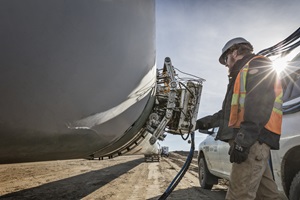Safety First: Comprehensive Pipeline Welding Inspection for every single Job Stage
Safety First: Comprehensive Pipeline Welding Inspection for every single Job Stage
Blog Article
Optimizing Performance: Pipe Welding Evaluation Best Practices
By carrying out finest techniques for pipe welding assessment, organizations can enhance processes, decrease errors, and improve project timelines. The thorough attention to detail needed in welding examination holds the essential to the lasting durability and integrity of the pipelines, making it a topic of utmost importance in the industry.

Value of Efficient Welding Assessments
Effective welding examinations play an important role in making sure the architectural honesty and safety and security of pipes. Proper evaluations are important to determine any problems, suspensions, or imperfections in the bonded joints that can jeopardize the total honesty of the pipeline system. By conducting extensive evaluations, assessors can find issues early, avoiding possible leaks, tears, or failings that can have significant environmental and security consequences.
Timely and accurate welding examinations also assist in preserving conformity with market criteria and laws. Sticking to these standards is not just a legal demand yet likewise an essential measure to guarantee the reliability and long life of the pipes. Moreover, efficient inspections can add to cost savings by decreasing the need for pricey fixings or substitutes because of welding issues that could have been protected against or dealt with during the evaluation process.
Making Use Of Technology for Inspections
To enhance the efficacy and accuracy of pipeline welding evaluations, the assimilation of sophisticated technologies has come to be significantly essential in guaranteeing accurate and detailed evaluations of welded joints. One of the essential technological developments in pipeline welding inspections is the use of automated ultrasonic testing (AUT) systems. By accepting these technological services, pipeline welding inspections can be conducted extra properly, leading to greater high quality welds, improved total safety, and decreased task timelines.
Developing Clear Evaluation Procedures
Developing clear assessment methods is important for ensuring consistency and integrity in the pipe welding assessment procedure. These protocols act as a collection of standards that detail the particular steps, requirements, and approaches to be followed during evaluations. By clearly specifying the evaluation protocols, all examiners associated with the process can understand their obligations and roles, resulting in a much more reliable and standardized assessment operations.

Regular evaluation and updates to the examination methods are likewise important to adapt to transforming sector criteria and requirements. By constantly refining and enhancing the procedures based on feedback and lessons learned, pipeline welding inspections can maintain the finest quality criteria and regulatory conformity.
Training and Certifications for Inspectors

Educating and accreditations for examiners are vital in ensuring the proficiency and effectiveness of people tasked with overseeing pipeline welding processes pop over here - Pipeline Welding Inspection. Properly educated inspectors have the required knowledge and abilities to successfully assess weld top quality, adherence to welding treatments, and conformity with industry standards and guidelines
Qualifications, such as those offered by the American Welding Culture (AWS) or the American Petroleum Institute (API), confirm an inspector's competence and capacity to do assessments to the highest possible requirements. These qualifications typically require extensive training, examinations, and ongoing expert advancement to make sure that inspectors stay present with the most up to date advancements in welding official statement innovation and examination strategies.
Along with formal qualifications, continuous training programs play a critical duty in boosting inspectors' capabilities. These programs cover a large range of topics, including welding processes, issue detection, safety procedures, and appropriate codes and criteria (Pipeline Welding Inspection). By purchasing comprehensive training and qualifications for inspectors, companies can promote the honesty of their pipe welding projects and mitigate the threats connected with low-grade welds
Continual Improvement in Inspection Procedures
Structure upon the structure of certified and skilled examiners, continual renovation in inspection procedures is vital for making certain the ongoing top quality and compliance of pipeline welding operations. By carrying out a system of constant enhancement, pipeline welding evaluation processes can progress to fulfill the transforming needs of the market, technological improvements, and governing requirements. This includes frequently evaluating and evaluating examination devices, treatments, and methods to identify locations for improvement.
One secret element of continuous improvement in examination processes is feedback. Gathering input from assessors, welders, engineers, and various other stakeholders enables a thorough assessment of present methods and the recognition of prospective areas for renovation. Furthermore, leveraging data and analytics can offer beneficial insights right into navigate to this site the effectiveness of inspection procedures, making it possible for notified decision-making for optimization.
In addition, purchasing training and development programs for assessors can make sure that they are equipped with the current understanding and abilities to execute their tasks successfully. Continual enhancement is a vibrant procedure that requires devotion and commitment from all stakeholders to drive excellence in pipeline welding evaluation techniques.
Final Thought
In conclusion, making best use of effectiveness in pipeline welding examinations is vital for making certain the high quality and safety of facilities jobs. By making use of modern technology, developing clear protocols, offering proper training and accreditations for examiners, and continually enhancing evaluation processes, companies can simplify their operations and minimize threats. It is critical for industries to focus on reliable welding evaluations to maintain high standards and meet governing needs.
Effective assessments can contribute to cost financial savings by lessening the need for pricey repair services or replacements due to welding defects that can have been avoided or corrected throughout the assessment process.
Establishing clear examination protocols is vital for guaranteeing uniformity and dependability in the pipe welding evaluation procedure. By clearly specifying the examination procedures, all inspectors included in the process can recognize their duties and obligations, leading to a more standard and reliable evaluation operations.
Clear examination procedures aid in decreasing the possibility of mistakes or oversights throughout the assessment procedure.Structure upon the structure of certified and experienced inspectors, continuous improvement in evaluation processes is vital for making certain the ongoing quality and conformity of pipe welding procedures.
Report this page